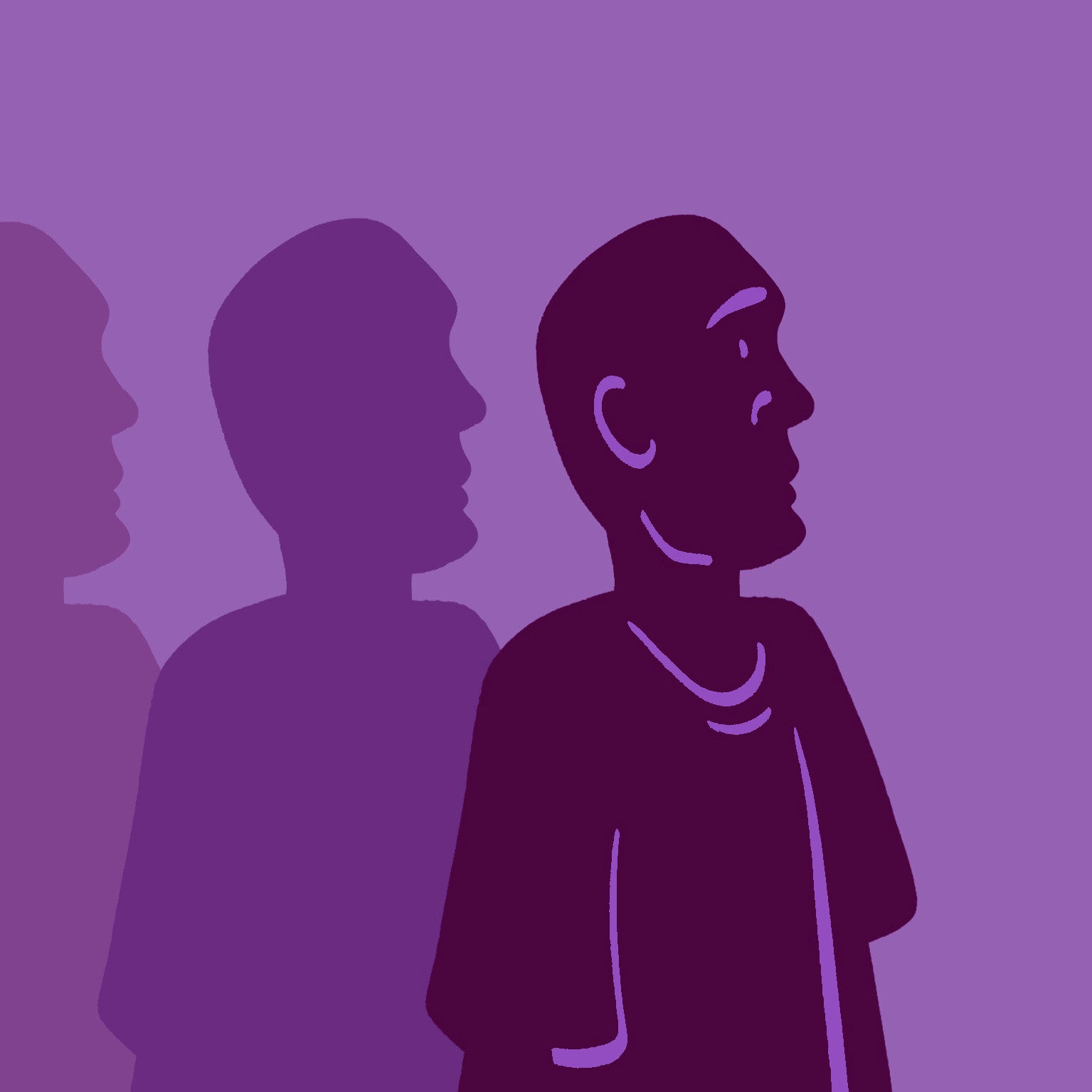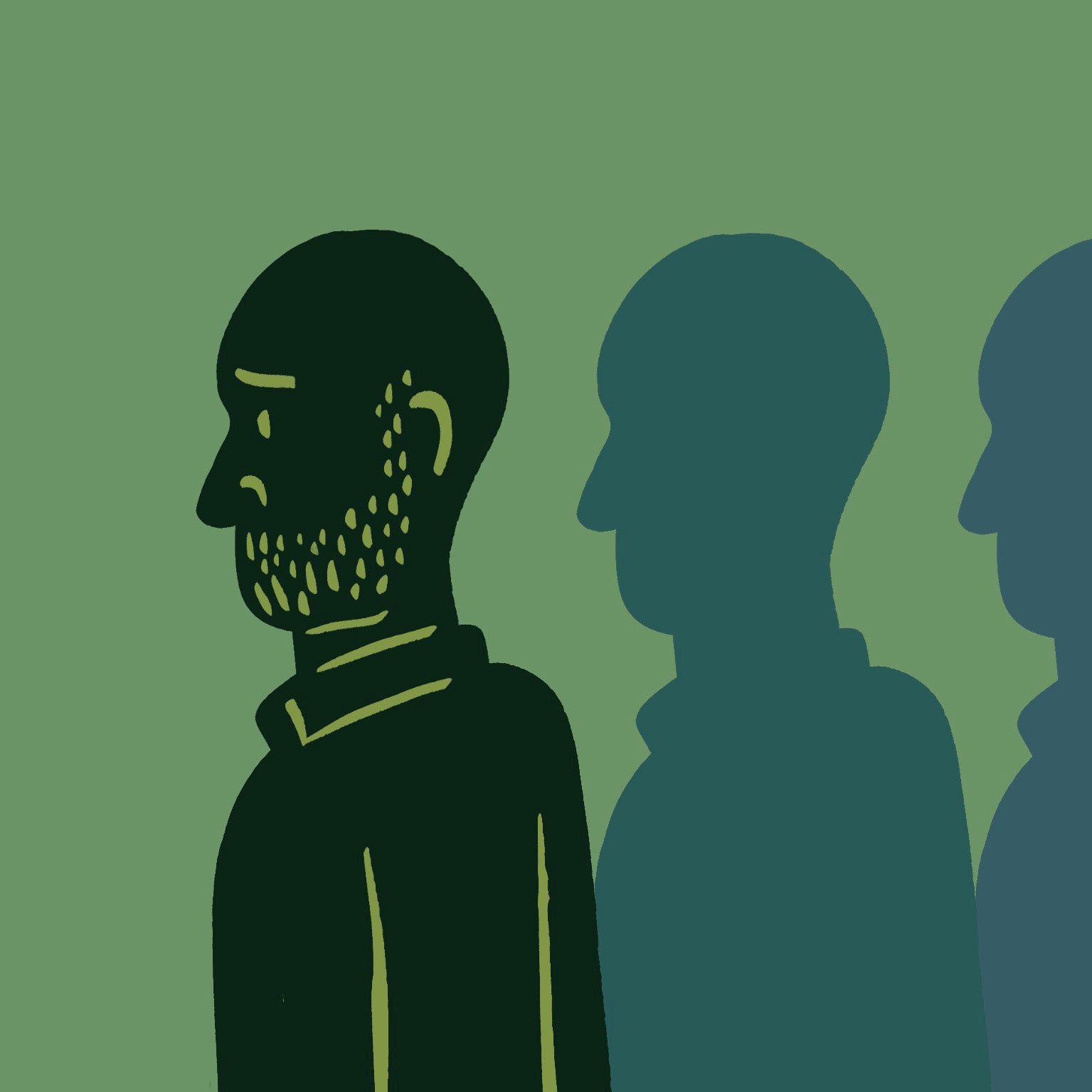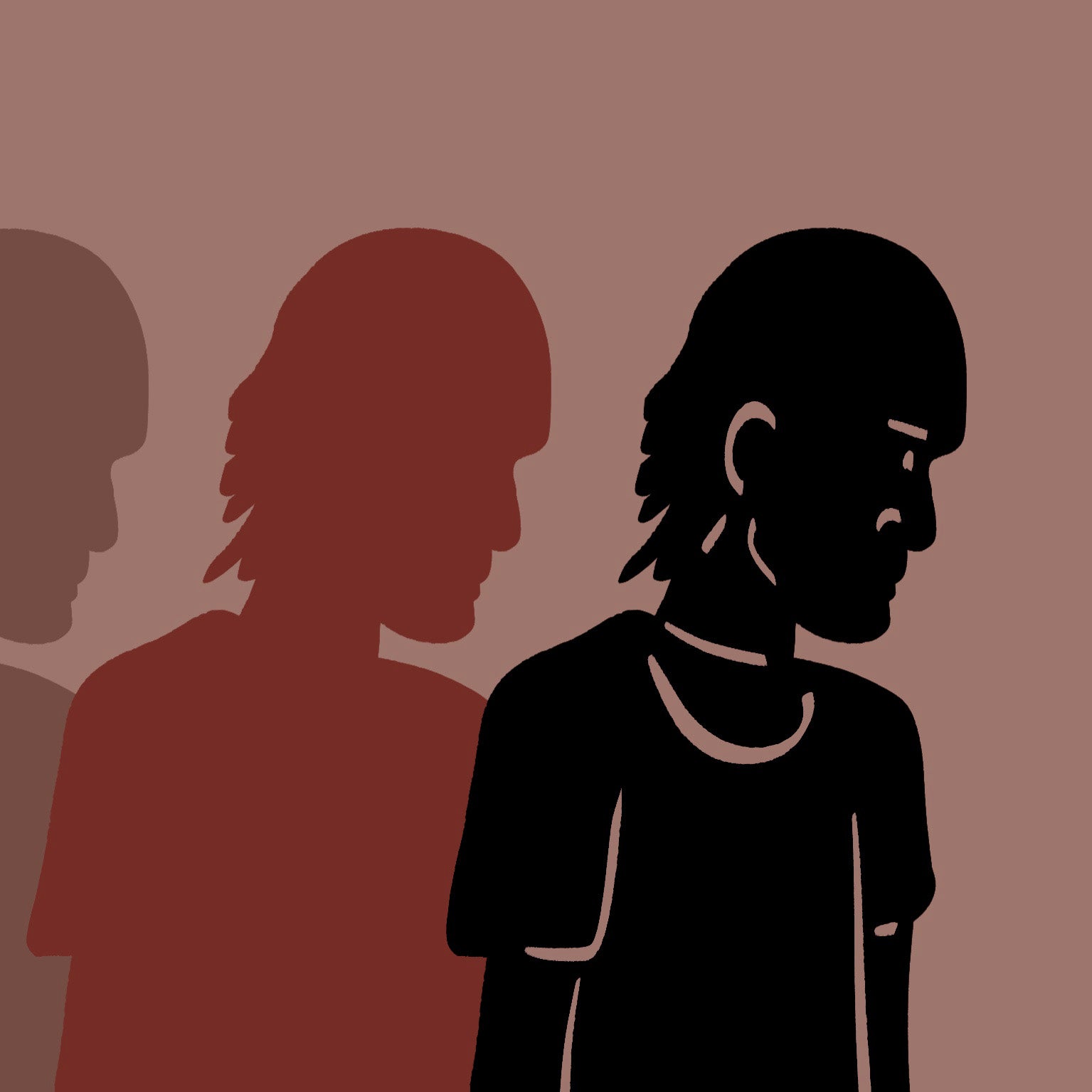Men are victims of domestic violence too – and more often than we think
Support in the UK largely serves one purpose: to help female victims. Margherita Santus looks at how things get complicated when it’s a woman dishing out the beatings

Paul was abused by his ex-wife for 10 years. She locked him out of their house more than 60 times, sometimes even dropping him miles away from home and forcing him to find his own way back. She smashed paintings over his head and, in 2014, she split his head open with a hair dryer, in front of their daughter. Paul, whose surname has been withheld to preserve his anonymity, went to hospital, and called three different domestic violence helplines. One told him they couldn’t help because he was outside their postcode. He claims the other two simply showed a lack of interest: “They point blank said no,” Paul recalls. “‘No, we’ve got no room for you here I’m afraid. We can’t support you.’”
Paul’s ex-wife was arrested within a week and formally charged after five months, originally with the offence of grievous bodily harm (GBH) with intent (section 18), then reduced to GBH without intent (section 20) – a far less serious offence, which makes the harm “accidental”.
“Even though she was standing over me wielding this hairdryer and smacking my head in with it and hitting me between the legs, the Court felt that the intent wasn’t there to do serious harm, or to actually kill me.” The final, shortened sentence was set to 16 months, half of which was suspended.
Sadly, Paul’s case is not a rare one. Though the latest annual data from the Office for National Statistics (ONS), released in 2020, confirms that women bear the brunt of domestic violence in the UK with 1.6 million victims, men are nonetheless nearly half as likely to be victims of partner abuse, with more than 750,000 cases reported. A ground-breaking 2018 report goes so far as suggesting that very few of these cases are the result of abuse within same-sex male relationships, with only 1 per cent of male-partner abuse victims reporting a male abuser.
As in Paul’s case, many of these sentences appear to show leniency towards female perpetrators. One man, who was stabbed in the head by his wife of 10 years and driven to two separate suicide attempts, had to fight for two years to obtain custody of his child. Another woman, who bit and scratched her husband while consuming cocaine around their distraught children, was still given access to the children after losing custody.
Paul’s account also depicts a process of victim-blaming based on his appearance. “As a victim, they want to deconstruct your character to make you appear to be an awful person, so they can build their defence on that,” he says. “I found it incredibly difficult to answer some of the defence barrister’s questions when they passed around photographs of me with my ex-wife saying ‘well, look, no biggie compared to her. Look how fat he is.’ One of the headlines in our local newspaper read ‘20-stone teacher’. That wasn’t even my weight.”
Even though she was standing over me wielding this hairdryer and smacking my head in with it and hitting me between the legs, the court felt that the intent wasn’t there to actually kill me
Paul also felt that his 10-year-old daughter’s testimony was given more weight than his in Court. In a two-hour video interrogation, the defence repeatedly asked her questions such as ‘Do you love your mum and dad?’ “It means that my own testimony alone, me as a male victim, does not count,” Paul laments.
In a period that spanned around 12 months, Paul had to attend hearings at the Crown Court, for his ex-wife’s charges, as well as two hearings at the Family Court – one for divorce and one for the custody of their daughter.
“In Family Court, my ex-wife decided to represent herself, so I was seated across the table from her. She was allowed to use that as a forum to threaten, make allegations and scream the house down. And the judge would allow her to do it.” Paul says the Family Court didn’t account for him being recognised as a victim in the Crown Court, and therefore didn’t physically separate the two former spouses. “These Courts don’t talk to each other. The Family Court was looking at the needs of my daughter and the Divorce Court was just looking at the financial side. And I didn’t come out of it terribly well…”
Never hit a woman
Mark Brooks, chairman of the ManKind Initiative – the only charity supporting male victims of abuse – says he was often asked: “What can we do as a society for men to be less masculine?”
Told to man up, that their looks make it difficult to make them believable as victims, Brooks sums it up by saying that “women have problems and men are problems”.

The Domestic Violence Disclosure Scheme, known as Clare’s Law, designates ways for police officers to disclose a person’s history of abusive behaviour to those who may be at risk from it. The law, named after Clare Wood, a woman murdered by a former domestic partner who police knew to be dangerous, is intended to reduce intimate partner violence. In certain circumstances, it permits police to disclose such information to the public. According to Brooks and information he collated from police forces, only 3 per cent of those who use the scheme are men.
The law’s language – including the use of ‘Clare’, a woman’s name in governmental schemes – reinforces this seemingly stark discrepancy between male and female cases of abuse. This then feeds into media reports of “clever” female perpetrators with “troubled pasts” who “demonstrate potential” – a far cry from the “THUGS” and “monsters” that male perpetrators are presented to be.
In reality, numbers are much closer than we are led to believe. These numbers fail to account for the fact that nearly half of male victims never tell anyone of their abuse (49 per cent of men, as opposed to 19 per cent of women), having likely been discouraged by societal prejudices. Male victims’ statistics are often not even recorded separately from overall statistics of domestic violence; in fact, they are included under statistics for Violence Against Women and Girls by the Crown Prosecution Service. Often, they are simply buried among records of other types of violence against men.
In Family Court, my ex-wife decided to represent herself, so I was seated across the table from her. She was allowed to use that as a forum to threaten, make allegations and scream the house down
Dr Elizabeth Bates, senior lecturer in Applied Psychology at the University of Cumbria, has long studied gender behaviours. She says there is no evidence to support the idea that men are more violent than women, and that when it comes to domestic violence, there are more similarities than differences.
“Men experience a real range of barriers when they seek help,” says Dr Bates. “How we talk to boys when they’re younger; how they are supposed to be able to look after themselves; and that they can defend themselves and be strong.” It then comes down to men feeling like they cannot be weak. “You still see women’s violence and men’s victimisation used as a tool of humour. The language we use when we talk about it, we say men ‘being under the thumb’ or ‘being henpecked’ whereas when a woman is experiencing the same, we wouldn’t use that sort of language, we take it much more seriously.”
“Boys are brought up to ‘never hit a woman’, while women are not taught that when growing up,” says Brooks, “I also think for male judges there’s an element of chivalry: they will probably sentence a man harder because they think it’s even more unacceptable for a man to hit a woman and will also be more forgiving of a woman.”
Instead of seeking to eradicate gender inequalities, lawmakers risk giving a totality of attention to the Strategy for Violence against Women and Girls, and lacking discussion over mens’ safety.
Men might even struggle to recognise the abuses they suffer as they don’t see themselves fitting within the picture of victims of abuse. If the posters, the charities available and the campaigns mostly paint a man towering over a woman, how would a man envisage himself in such a scenario?
Since the Covid-19 pandemic, victims have reported being more isolated than ever, and less able to leave because of lack of money as a result of furlough and redundancy
Aside from the failure to recognise their relationship as abusive, men do not seek help because of a fear of disclosure, according to a report by the British Medical Journal. Brooks reports that 64 per cent of men would not have called the helpline if they could not remain anonymous, and only one in six would tell the police.
Martin’s marriage was a testament to the intimidation under which male victims can live. His wife once punched him in the face so hard that she broke a finger. Martin rushed her to hospital, where the doctor called it a ‘boxer’s break’, or fracture, and offered her help to press charges against Martin. She persistently used this as a threat against him, saying “all I have to do is call the doctor, they will all believe me, I can even just press my body against the wall and say you caused the bruise.”
Family Law solicitor Roger Waters describes his female clients to be very open in describing the abuse they have experienced, while males appear “prouder, often ashamed”. For him it’s about culture, “stigma plays a large part. Traditionally, the male has always been the strong independent model, and to actually stand up and say that they have been beaten up; they see it as a sign of weakness, as a source of embarrassment.”
Or, too often, their stories would be used to feed contradictory narratives. “If a man is silent, he is coercive and controlling because he may become violent. If a man threatens suicide, he is controlling and coercive.” These are quotes taken from a course for barristers, solicitors and social workers taught by Dr Bianca Jackson at the Coram Chambers Law Works Domestic Violence Training.
If a man is silent, he is coercive and controlling because he may become violent. If a man threatens suicide, he is controlling and coercive
According to data extracted from the ONS and collated from interviews, at least 12 men take their own lives every day, with studies showing that 34 per cent of male suicides are driven by relationship breakdown and alienated fathers are 300 per cent more prone to suicide.
The screening process – a police officer lottery
The unconscious bias in the system is proven first and foremost by the difference in screenings. The first thing to note is that the National Domestic Violence Helpline is run in partnership between Refuge for women and children against domestic violence and Women’s Aid, both organisations make no mention of men or boys. The latter was one of the many that refused to help Paul.
In 2017, Cardiff-based Anne O’Regan exposed the helpline when his grandson called up to seek help as a victim and was screened as a perpetrator. O’Regan voiced her concerns with the Equalities and Human Rights Commission (EHRC), which “deemed absolutely essential that male callers to domestic violence helplines are screened to see if they are perpetrators”.
The EHRC response also included the following passage: “It is our view that there is material difference in circumstances between a man calling domestic abuse support helpline and a woman seeking support.” It argues that because women comprise the “overwhelming majority” of victims of domestic abuse, it is not possible to carry out the same proportion of screenings on women callers. Interestingly, while over a third of victims are men, only 3 per cent of callers are men, raising further questions over the possibility that screening could provide additional deterrent and stigma for male victims.

David Edwards, from Chorley, Lancashire, repeatedly called a helpline for support. The police intervened several times but, in 2015, Edwards was killed by his wife who stabbed him in the heart with a kitchen knife. Recounting this story, Brooks comments: “They didn’t take him seriously because he was a man and he ultimately died, was murdered, because of it.”
Among those who suffered domestic abuse in 2017-18, 4.3 per cent of men suffered internal injuries or broken bones and teeth, against 0.4 per cent of women. Overall, 31.8 per cent of men and 22.7 per cent of women in abusive relationships suffered from physical injuries.
The fight for a safe bed
In the fairly rare cases in which help is provided to male survivors of abuse, the number of bed spaces available to men in safe houses is then limited. According to Brooks, there are currently 38 organisations who welcome men, and of the 253 spaces they collectively hold, only 81 are dedicated for men – often in mixed houses.
Having fewer services available also means there is an increased chance that when a bed becomes available, it will be too far from the victim’s residence. Among callers to the ManKind Initiative, of the 80 men seeking refuge on average every year, most decide not to accept accommodation because it would mean leaving their children and their job behind.
Thanks to schemes like ‘Everyone In’ during and following lockdowns, we also know that one third of men who are rough sleepers are escaping domestic abuse
Since the Covid pandemic, victims have reported being more isolated than ever, and less able to leave because of lack of money as a result of furlough and redundancy. Conversely, this comes with greatly increased demand: calls to helplines rose by one quarter against the previous year, and visits to websites like the ManKind Initiative grew by 75 per cent.
Partner abuse against men is also said to be a pipeline to homelessness. When looking at the ONS estimated number of people sleeping rough in England on a single night in Autumn 2020, 2,277 were male and 377 female, making men 85 per cent of the total. Albeit a decrease by 37 per cent (1,578 people) from 2019 thanks to schemes like ‘Everyone In’ during and following lockdowns, we also know that one third of men who are rough sleepers are escaping domestic abuse.
The role of the child
Family Courts are not necessarily concerned about the degree of violence or abuse there has been in the household, but more so about the likely impact on the child. Their verdict is influenced by whether the child was present or aware at the time of the abuse.
In Terry’s case, the child was not only present but a victim too. Hayley soon fell pregnant after meeting Terry on an online dating site, which led to the couple deciding to spend their future together. Both Hayley and Terry had children from previous relationships. Terry later found out that Hayley was an alcoholic in recovery, and that her four children lived with her ex-husband after a drunken suicide attempt by Hayley.
She slowly started showing controlling and manipulative behaviours, including hacking into Terry’s phone, which then escalated into physical violence, such as throwing objects at him. Hayley also repeatedly refused meals to Terry’s son, or else served him last and slammed his plate. Terry found out Hayley had been drinking during the pregnancy, and when their daughter was born, she threw him out of the house they shared. After he left, she called a social worker telling them he had been violent and abusive towards her and stole some of her possessions.
Paul also believes that if his ex-wife had shown any remorse, pleaded guilty or had any sympathy towards their daughter, she would have received a shorter sentence
Terry is still fighting for the custody of his son and daughter, but Hayley’s lies and threats to make him lose his job and contact with his children, has put him off filing an application for a Court order.
Legislation, aimed at being protective of victims but following stereotypical views on gender, can often provide another screening step that tends to prevent men accessing legal aid.
The Laspo (Legal Aid Sentencing and Punishment of Offenders) Act 2012, enacted in 2013, added the need for evidence of domestic violence to obtain Legal Aid for Family Court proceedings. According to charity Families Need Fathers, since then ex-parte non-molestation injunction orders (meaning without notice and no contact with the accuser, usually the mother) have increased and became the most popular domestic violence allegation used to get Legal Aid. They say the Legal Aid gender split has since gone from 40 per cent male, 60 per cent female pre-Laspo, to 15 per cent and 85 per cent, respectively, after 2013.
Many men end up representing themselves in Court as a result.
The aftermath of Paul’s court proceeding
Paul’s daughter, 10 when the pair left the abusive household and now 17, is happy to have a no-contact order with her mother. “We did say that she could send presents and letters. Sadly, she uses that loophole to send some of the most horrible letters and cards to my daughter, making my daughter feel like an awful person.”
Paul also believes that if his ex-wife had shown any remorse, pleaded guilty or had any sympathy towards their daughter, she would have received a shorter sentence and not a custodial one.

When his ex-wife was released, Paul started receiving messages from friends on Facebook in breach of probation. She lives in Northampton while Paul and his daughter live in Wiltshire, roughly 100 miles apart. Yet, no distance seems to reassure them completely.
“There were months when she was moved from one house to another with the help of people from our local church. There were people there that worked at my daughter’s school and passed on information about their events in town so she could visit our daughter without me when I was at work. They felt they were doing the right thing because they couldn’t believe she had done what she had been accused of.”
Paul is concerned that the time spent in prison hasn’t helped rehabilitate his ex-wife, and that a psychological assessment would have helped to address the correct treatments for her.
Difference in custodial sentences?
“Females are less likely to receive custodial sentences,” says solicitor Roger Waters. “I’ve had cases, often unheard of, where children were changing their residence to stay with the father. A typical example will be where the mother is clearly refusing to allow any form of contact between the children and their father, and despite numerous orders, they would find reasons to repeatedly float the order.”
Surveys show that 89 per cent of men don’t leave their abusive relationships over concern about the children, and 68 per cent fear reporting the abuse will mean never seeing them again. In fact, twice as many men as women keep living with their abuser. Lockdowns in England have also been used as an excuse by partners to breach agreements in child contacts.
Discussing services and schemes available with Paul, he told me: “As far as Clare’s Law is concerned, purely by the fact that it is called Clare’s Law and not Kevin’s Law, it doesn’t feel as though it really applies to us. But even in 2022, I don’t think British society is ready to change that.”
Domestic violence’s laws should be freed from pronouns. Clare suffering abuse doesn’t exclude Kevin from experiencing the same. However, it does exclude Kevin from getting help.
Join our commenting forum
Join thought-provoking conversations, follow other Independent readers and see their replies
Comments



Bookmark popover
Removed from bookmarks